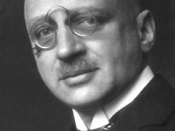Without industrial fertilizers, about three times more farmland than is currently available would be required to sustain the world's population. In addition, half of the protein we consume is produced in crops (National Energy Education Development project, 2013) and this process is facilitated by nitrogen in the soil. The most common nitrogen compound for fertilizers is ammonia, produced in the Haber-Bosch process, which reacts nitrogen gas with hydrogen gas. While this industrial process of producing ammonia sustains a significant portion of the world's population, certain drawbacks must also be considered. The necessary evil of pollution and energy consumption in altering the conditions of chemical reactions is an issue that cannot be overlooked in this day and age where resources are getting increasingly scarce. Overall, the advantages that this innovation has brought to society far outweigh the negative environmental backlash.
The chemical bonds of ammonia are easier to break than in nitrogen molecules in the air, hence mass production of ammonia would be beneficial to plant growth and other trades involving nitrogen.
However, the percentage yield of ammonia from the reaction of hydrogen and nitrogen at 1 atm is only 0.5%. Scientists have worked for centuries to shift the position of equilibrium in this reaction to increase the yield for industrial use (Zmaczynski, 2002), although this reaction was not successfully recreated in a laboratory environment until Haber discovered the conditions of sufficient rates of reaction. According to Le Chatelier's principle, any change to a reaction at equilibrium will be reversed through increasing the rate of the opposite reaction of any increase, hence shifting the position of equilibrium to the opposite side. The German scientists developed equipment that provided the high pressures and temperatures necessary for the chemical reactions to occur.
In the early years of the 20th century,


